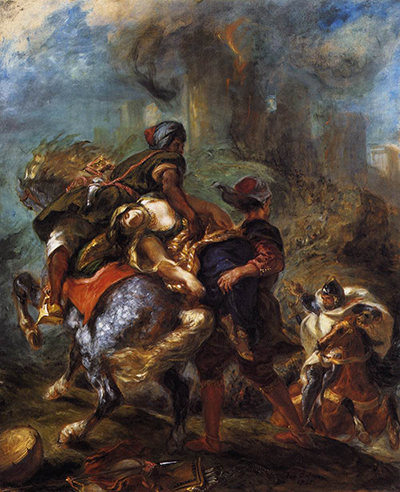Eugene Delacroix completed two versions of the same theme in 1846, namely the Abduction of Rebecca. The version that you see before you here is in the collection of The Metropolitan Museum of Art, US.
It was Ivanhoe, a text from Walter Scott, as part of his Waverley Novels, that would provide the inspiration for what we find in front of us here. Delacroix loved English literature for a period of his career and regularly visited this font of creativity in order to give him ideas for future artworks. At that point the Romanticist movement was a combination of some extraordinary literature and art from either side of the English Channel. He also found that his expressive style which made use of busy canvases and countless figures was well suited to the type of content being written by Scott and also Lord Byron. You will find countless more examples of these individuals within his career. He became, unquestionably, an Anglophile for a period, and would eventually spend time in the UK in order to satisfy this growing interest. The Romanticist group were a combination of famous writers and artists from both France and the UK, with further contributions coming from elsewhere in Europe too. The influence of literature would continue into the Pre-Raphaelite movement, for example with the likes of Lady of Shalott and Hylas and the Nymphs from John William Waterhouse.
The dramatic scene features Rebecca being carried away by two Saracen slaves, under the orders of Bois-Guilbert, a Christian knight. We see the castle of Front de Boeuf alight in the background, whilst closer to us are a flurry of characters desperately trying to gain ownership of the significant Jewish lady. Delacroix places the key figures directly in front of us so that we can see the facial expressions in as much detail as possible. There are also some delightful touches of the various items of clothing which was typical of Delacroix. Her pose, lying over the horse, and her expression of almost unconsciousness, makes her look extremely vulnerable, and very much in need of help.
Not only did Delacroix produce two different versions in 1846, but also he then created another copy of this painting, virtually identical, in 1859. That painting is now under the ownership of the Louvre, which itself holds amongst the best collections of his work anywhere in the world, including multiple paintings and also a large number of study drawings. The earlier one is also sometimes called by its much longer title of Rebecca Abducted at the Order of the Templar Bois-Guilbert during the Sack of the Castle of Front-de-Boeuf, though it proves much more helpful to academics to reduce this down to something more manageable. This is amongst the most Romanticist in style of all of his works, with detail sometimes reduced in favour of almost abstract lines which provide more emotion than anything - a good example of this in action elsewhere would be Turner's Rain Steam Speed, where more of a suggestion of form is used than precise detail.




